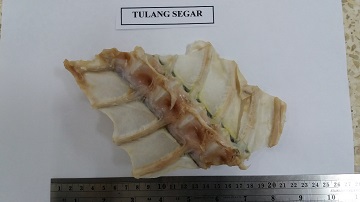A Group of IPB Students Implemented Research Program on the Utilization Tuna Fish Bone for Pollutants Absorbent

Five students of the Bogor Agricultural University (IPB) consisting of Rosma Alami, Fatimah Zahra Annas, Atiqya Nur Assyfa, Mamluatun Nurrohmah and Neli Nabila Untum Created a tuna-based bone adsorbent, their project had been sponsored by Program Kreativitas Mahasiswa bidang Penelitian (PKM-P Student Creativity Program for Research 2017. An adsorbent is an insoluble material coated by liquid on the surface, including capillaries and pores. A material is said to be adsorbent when it has the capacity to contain a definite amount of liquid in small chambers similar to a sponge. The group of students of IPB created adsorbent made of activated carbon, natural zeolite, chitosan and complex structure of inorganic composite material.
The reason why they designed this project, as they understand population growth and ever increasing activities in major cities, as well as industrial development in major cities in Indonesia this may lead to environmental pollution and degradation. Due to population pressure, natural resources in the cities are depleted at a fast rate due to population pressure. Recently a huge amount of fluoride in coal has been released into indoor environments by the combustion of coal and fluoride pollution seems to be increasing in Indonesia. It may cause diseases, allergies or death of humans; it may also cause harm to other living organisms such as animals and food crops, and may damage the natural or built environment. Since airborne fluoride from the combustion of coal pollutes extensively both the living environment and food, it is necessary to reduce fluoride pollution caused by coal burning.
Fluoride is generated from activities such as coal combustion, power plants, welding operations, steel, iron, aluminum, zinc, phosphorus, chemical fertilizers, bricks, plastic glass, and cement. Fluoride does not only reduce air quality, but water, soil, vegetation, plants, and animals and humans rely on food sources.
Fluoride elements are found in everyday life, even some are found in food and beverages consumed daily. Fluorine is found in nature in the form of calcium fluoride, called fluorite, which forms regular crystals. "Our research program had been carried out in Aquatic Product Diversification and Processing Laboratory, Department of Aquatic Product Technology, Faculty of Fisheries and Marine Science of IPB and using Tuna bone (Thunnus albacares) supplied from Muara Baru. Fish bones have been cleaned, calcination was then conducted using high-temperature the extraction of hydroxyapatite. Hydroxyapatite is an inorganic component that makes up the hard tissues of animals and humans (bones and teeth). Then, the hydroxyapatite was mixed with chitosan for further studies, "explained Rosma Alami, Chairman of the PKM-P team.
The group expected that this study was conducted to determine the absorption ability of hydroxyapatite using tuna bone waste on various concentrations will increase the optimal utilization of tuna fish, not only its meat but also the bones. In addition, they also hope that his research can beneficial for the community in solving environmental problems. (Wied)



